As winter winds sweep across the rugged landscape of the Keweenaw Peninsula, its historic destinations take on a serene and snow-covered charm. While some attractions hibernate beneath blankets of snow during the colder months, the Keweenaw doesn't cease to be a captivating canvas for those seeking to unravel its past. Follow along as we share our top historical treasures waiting to be discovered during the frosty winter months.
Houghton
Named after Michigan’s first state geologist, Houghton serves as an excellent starting point for your adventure into Keweenaw history. During the peak of the copper mining boom, the Houghton waterfront was adorned with warehouses, railroads, and streetcars. The bustling Portage Canal witnessed a constant flow of ships, transporting supplies and exporting copper mined from the region. As time marched on, buggies and streetcars faded away, and dirt roads gave way to pavement. The eventual decline of copper mining led to the repurposing of many commercial buildings. Despite these inevitable changes, Houghton retains much of its original character. As you wander through the downtown area, keep an eye out for the hidden relics that tell the story of Houghton’s vibrant past. Be sure to visit the following attractions during your time in town.
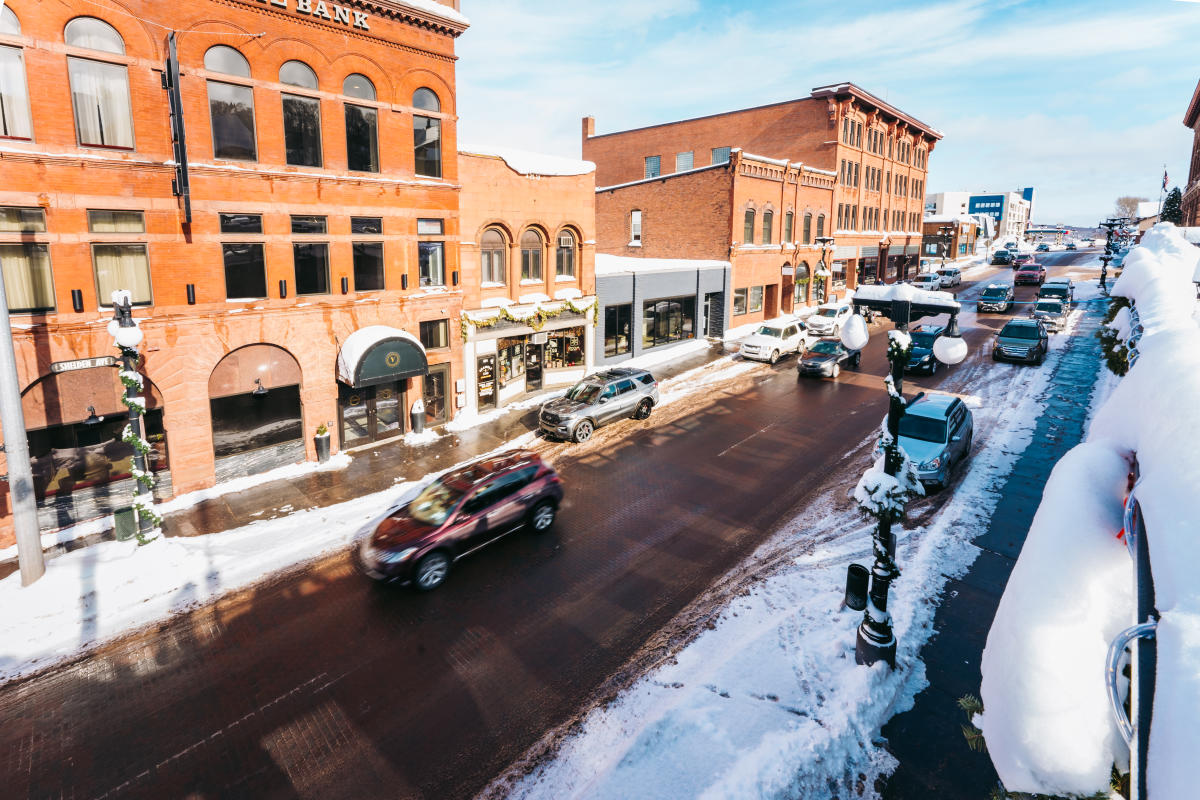
Houghton's downtown echoes stories of yesteryear. (Pure Michigan)
A.E. Seaman Mineral Museum
The A.E. Seaman Mineral Museum at Michigan Tech features some of the finest copper specimens from the Keweenaw Peninsula region. This is a great destination for those interested in learning about the important “red metal” that helped build our historic communities. Beyond copper specimens, you will find one the best collections of rocks and minerals from the Great Lakes region and unique specimens from around the world.

Step inside the A.E. Seaman Mineral Museum at Michigan Tech and marvel at the jaw-dropping mineral collection.
Reserve some time to take in the magic of jaw-dropping minerals and learn about their significance in everyday life. As the Official Mineral Museum of Michigan and the Unofficial Mineral Museum of the Great Lakes Region, we promise that this is one experience that you will not want to miss.
Carnegie Museum of Houghton
Housed in the former public library building in Houghton’s historic downtown district, the Carnegie Museum showcases changing exhibits that highlight cultural and natural history. The construction of this two-story sandstone and brick building was made possible through a $15,000 grant provided by Andrew Carnegie in 1909. The library moved to its new location around 2006 and a group of interested local citizens proposed to the Houghton City Council that the newly vacant building become a museum.
The museum offers events and programs throughout the year that often include fun hands-on activities suitable for all ages. Stop by to explore their current exhibits and view historic photographs from Houghton’s yester-year. While you’re visiting the museum, be sure to grab a brochure that will take you on a self-guided walking tour of Houghton’s historic downtown.
Dee Stadium
Leisure activities played a significant role in the lives of mine workers and their families, with hockey emerging as a popular sport within our community. Located on the Houghton waterfront, the Dee Stadium is one of the oldest continuously operating rinks in the country. Houghton is often referred to as the “Birthplace of Professional Hockey,” and guests can learn about this history by visiting the History of Hockey Museum in the Kenner Ruohonen Memorial History Room at the Dee Stadium. Be sure to check the rink schedule for open skating or games featuring the Portage Lake Pioneers hockey team, one of the oldest semi-professional hockey leagues in the United States.
Hancock
Founded by the Quincy Mining Company in 1859, Hancock served alongside Houghton as an important hub during the copper mining era. Hancock is well known for its strong Finnish American population and being home to the most reliable copper mine in the Keweenaw. The downtown area features many impressive sandstone and brick buildings, such as the former Scott Hotel, built in 1906 on the first block of Quincy Street. The Scott Hotel is still standing today, but it no longer operates as a hotel and is now known as the Scott Building. Take a stroll through the downtown area to uncover the narratives behind the buildings you see. Here are few places of historical interest to visit as you explore the charming town of Hancock, Michigan.
Finnish-American Heritage Center
During the peak of the copper mining boom, tens of thousands of immigrants migrated to the Keweenaw to work in the copper mines. A good portion of these immigrant mine workers were of Finnish descent. The Finnish American Heritage Center has served as a cultural community center for Finnish Americans since 1990. This Keweenaw National Historical Park Heritage Site includes the Finnish American Historical Archive and a museum. It’s a great destination for anyone interested in learning about the history of Finnish Americans in the Keweenaw Peninsula and offers regular performances, art exhibits, and events that highlight Finnish culture. Make sure to visit the nearby North Wind Books, where you can discover literature written in Finnish, delve into books on Finnish culture, and explore publications covering the Keweenaw Peninsula, the Upper Peninsula, and Lake Superior.
Orpheum Theater
The Orpheum Theater was built by the Mason family in 1910 and operated as a vaudeville theater until the 1920’s when it began showing motion picture films. During the mid-1950's the theater took on a new partner and was renamed the Pic.
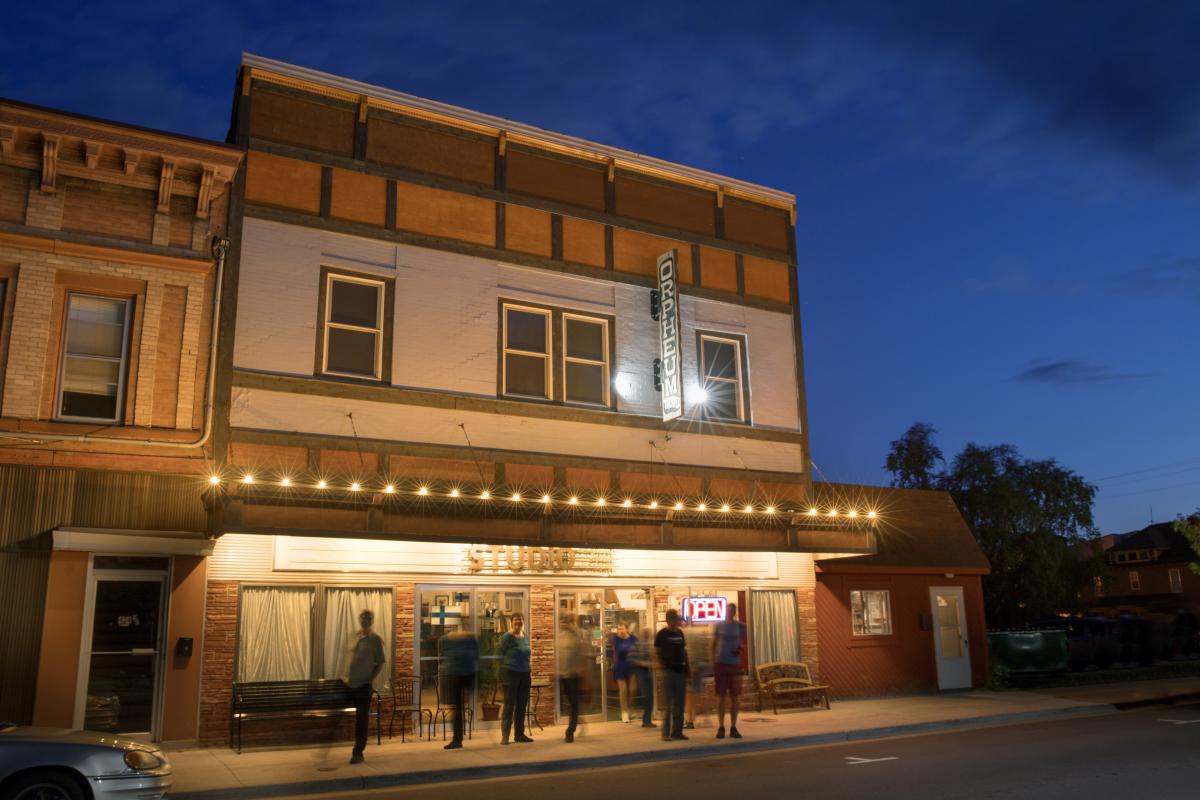
The Orpheum Theater now operates primarily as a live music venue.
Today, it operates primarily as a live music venue and occasionally plays host to other community events. The Theater includes Studio Pizza, a bar area, and 5th & Elm Coffee & Deli. Be sure to check our events calendar for upcoming performances in this historic venue. It’s a fantastic place to kick back and enjoy dinner and a show.
Quincy Mine
Standing tall at the top of Quincy Hill in Hancock, is the famous Quincy Mine. The Quincy Mine is often referred to as “Old Reliable” because of the company’s ability to pay dividends to investors every year from 1868 through 1920. Quincy Mine is open for tours on select dates throughout the winter and offers a glimpse into the unique challenges faced by miners during the harsh winter months.

The Quincy Mine offers tours during the winter months.
The tour takes guests through the No.2 Shaft Rock House and the No. 2 Hoist House which houses the world’s largest steam-driven mine hoist. This hoist was used to lift heavy ore from the shafts deep below Earth’s surface. From here, visitors get to enjoy views of Houghton and Hancock as they are transported down the hillside on the cog wheel tram to the entrance of the 7th level of the mine. The tour continues through the mine shaft and offers insight into what life was like for miners working deep underground. Be sure to dress warmly for your tour as you will spend some time walking outside and the mine stays at a temperature of just 43°. Tickets for scheduled upcoming tours can be purchased here. Private tours typically may be booked for groups of four with 24-hour advance notice. Call ahead to arrange private tours.
Calumet
During the peak of the copper mining boom, Calumet (originally known as Red Jacket) was bustling with the energy of immigrant mine workers and the streets were lined with businesses and saloons. Calumet and Hecla Mining Company operated out of Calumet and was one of the most productive mines during the late 1800’s. Copper Mining was a booming business in Calumet up until the great Copper Country Strike of 1913-1914. This strike was spearheaded by 25-year-old Anna Klobuchar Clemenc ("Big Annie") as an effort to improve labor conditions for miners. This important movement originated in Calumet and was a turning point in the history of the Copper Country.
Today, the streets of Calumet still retain much of their original appearance and character. The downtown district is listed on the National Register of Historic Places and as a National Historic Landmark. One of the best ways to explore Calumet’s historic district is by taking a self-guided walking tour. The Visit Keweenaw Welcome Center has both the Downtown Calumet and Industrial Calumet Booklets for purchase. These booklets were created by the Keweenaw National Historical Park and allow visitors to step back in time as they explore the buildings within the historic district. Alternatively, check out our guide that takes you on a tour of Calumet, retracing “Big Annie’s” footsteps. Be sure to check out these historic Calumet attractions along the way.
Keweenaw National Historical Park Visitors Center
The Keweenaw National Historical Park does an excellent job of keeping the history of copper mining alive. Stop by the Park Headquarters and Visitors Center on 5th Street and learn about the Keweenaw’s copper history by exploring interactive museum exhibits and artifacts from the past. Keep in mind that the Visitor Center has limited hours during the winter months. Be sure to check their schedule before you go.
Italian Hall Memorial Park
On Christmas Eve of 1913, a tragic event unfolded at the Italian Hall. The venue was hosting a Christmas party on its second floor when a false alarm of "fire" triggered widespread panic. As attendees hurried down the staircase to try to evacuate, 73 lives were lost, including 59 children.
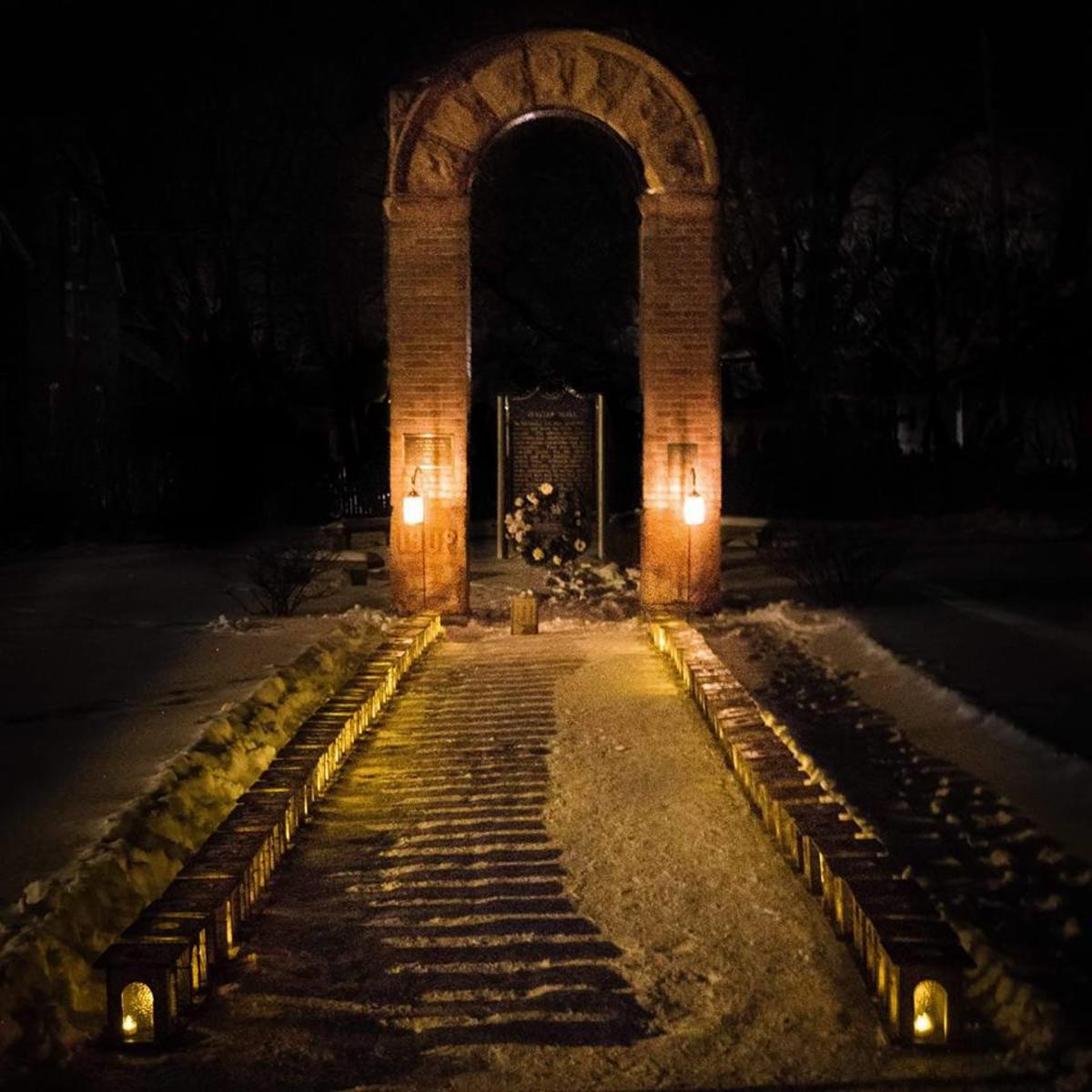
Italian Hall Memorial Park lit up with luminaries for the annual memorial on Christmas Eve. (Keweenaw National Historical Park)
This Christmas party was organized by the Western Federation of Miner’s Ladies Auxillary (headed by “Big Annie”) in hopes of spreading holiday cheer to striking miners and their families. The devastation of the Italian Hall Disaster was profound, especially amid the ongoing challenges of the Copper Country Strike of 1913-1914. The Italian Hall was demolished in October 1984 and a memorial park was built at the site with the original stone archway repositioned in the center of the lot. The memorial park serves as an important historical site for those wishing to deeply understand this important part of Keweenaw history.
Calumet Theatre
One of the most stunning buildings in Calumet is the Calumet Theatre. This turn of the century opera house is the oldest municipally built and owned theatre in the country and is on the National Register of Historic Places. The theatre's interior is adorned with exquisite detailing, balcony seating, and fantastic built-in acoustics.
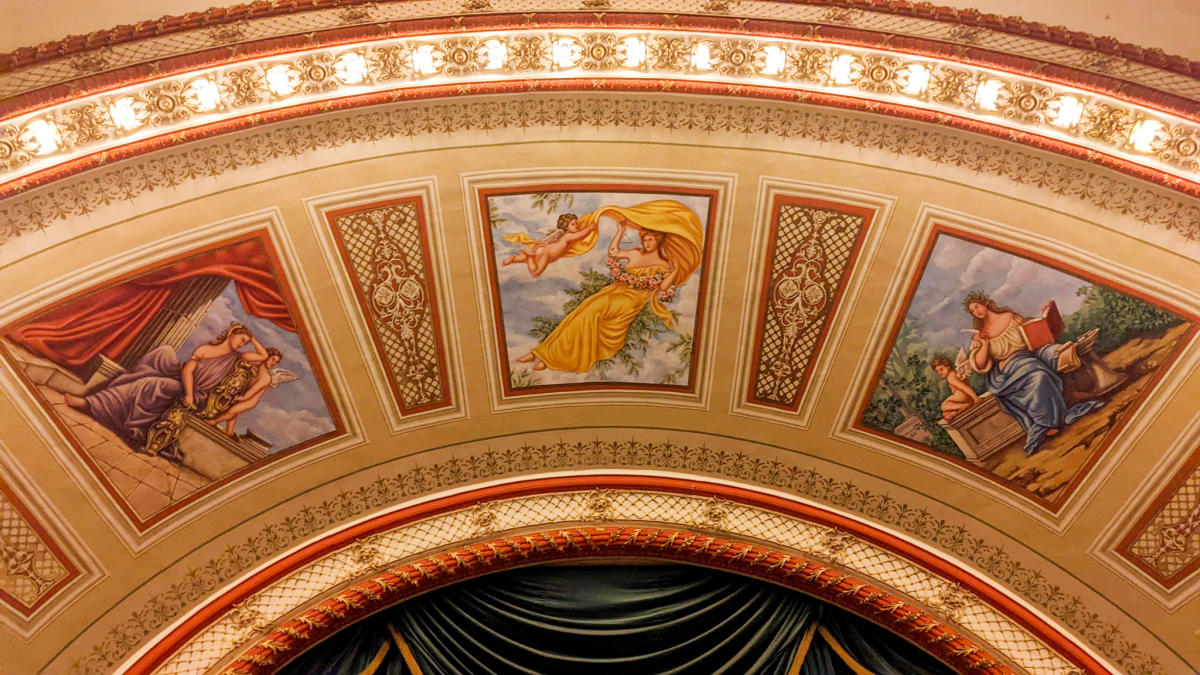
The Calumet Theatre is adorned with exquisite details.
Throughout time, the theatre has featured performances from renowned performers and even operated as a movie theatre. Today, it continues to operate as a quality entertainment venue and provides visitors with a unique way of connecting with the Copper Country’s past. Be sure to check the Calumet Theatre website for upcoming events.
Calumet Colosseum
Built in 1913, the Calumet Colosseum is considered the oldest operating continuous-use ice rink in North America. Since 2011, the Colosseum has also been home to the International Frisbee/ USA Guts Hall of Fame. In 2019, the Colosseum was the winner of Kraft Hockeyville USA and was awarded $150,000 for upgrades as well as the opportunity to host the NHL pre-season game between the Detroit Red Wings and the St. Louis Blues.

The historic Calumet Theatre during the Kraft Hockeyville USA pre-season game.
Step inside this important community rink and explore the International Frisbee/ USA Guts Hall of Fame in the second-floor ballroom or explore showcases on the first floor to learn about significant moments in Colosseum hockey history. If you’re interested in watching a game or public skating, weekly arena schedules are posted here.
Keweenaw County
As you venture north of Calumet and enter Keweenaw County, there will be many historical attractions to explore in the great outdoors.
The Keweenaw Snow Gauge
Just north of Mohawk on US-41, you will find the world’s largest snow gauge. Standing at a height of over 30 feet, this popular roadside attraction demonstrates the sheer volume of snow that Keweenaw County receives in a winter. The highest amount of snow recorded was 390.4 inches (32.5 feet) during the winter of 1978-1979. The 54-year average indicated on the sign is 240.8 inches.
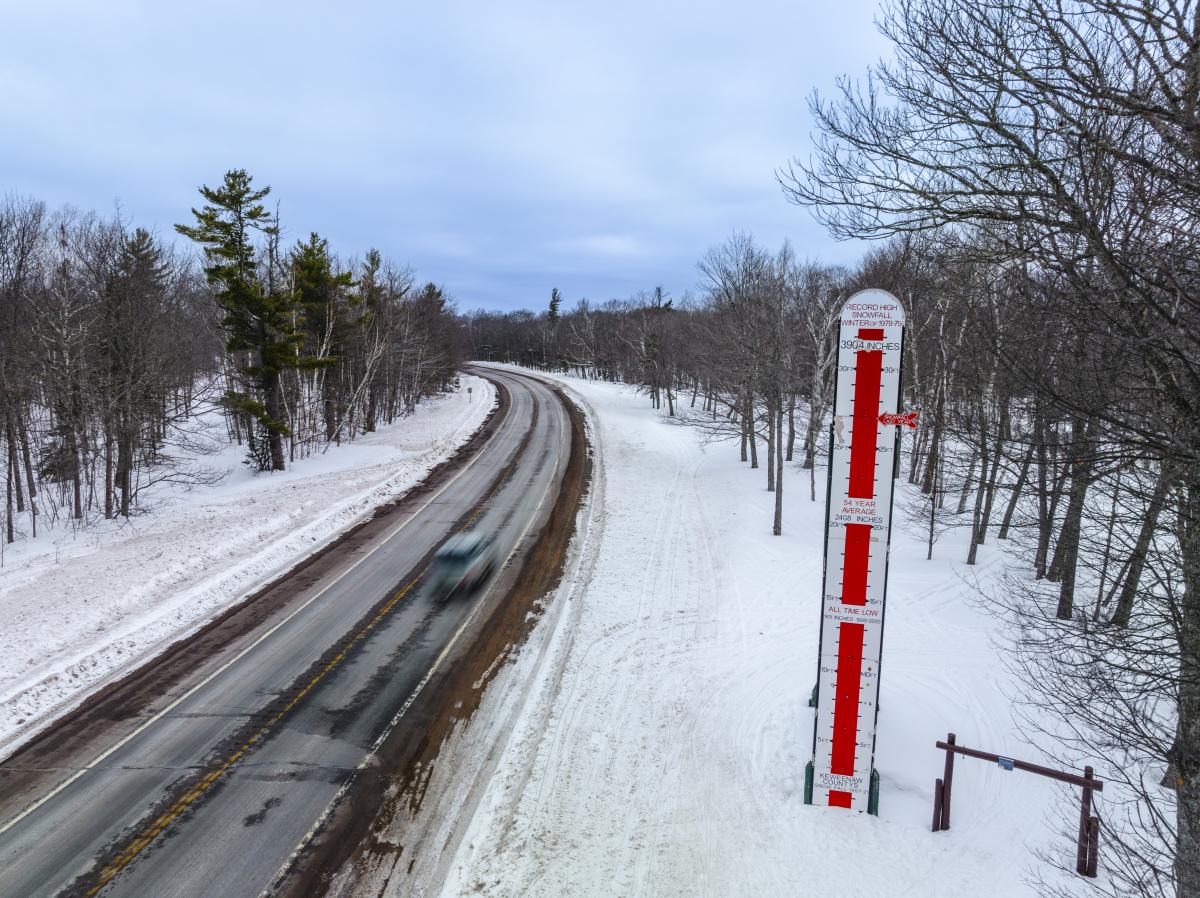
The Keweenaw Snow Gauge shows historical snowfall data for Keweenaw County.
As you visit this iconic site, imagine what snow removal looked like throughout the years. When horses and buggies ruled the streets and streetcars and trains traversed the Keweenaw Peninsula, snow affected Copper Country residents different ways than it does today.
Eagle River Timber Bridge & Lower Eagle River Falls
Just off M-26 in Eagle River, MI are two historic attractions that you won’t want to miss. After crossing the highway bridge in Eagle River, take a right and park in the parking area where you’ll find a Michigan Historical Marker sign. Walk onto the pedestrian bridge for views of the historic timber bridge and Lower Eagle River Falls. The snow on the pedestrian bridge should be packed down from other visitors and easy to traverse wearing winter boots.
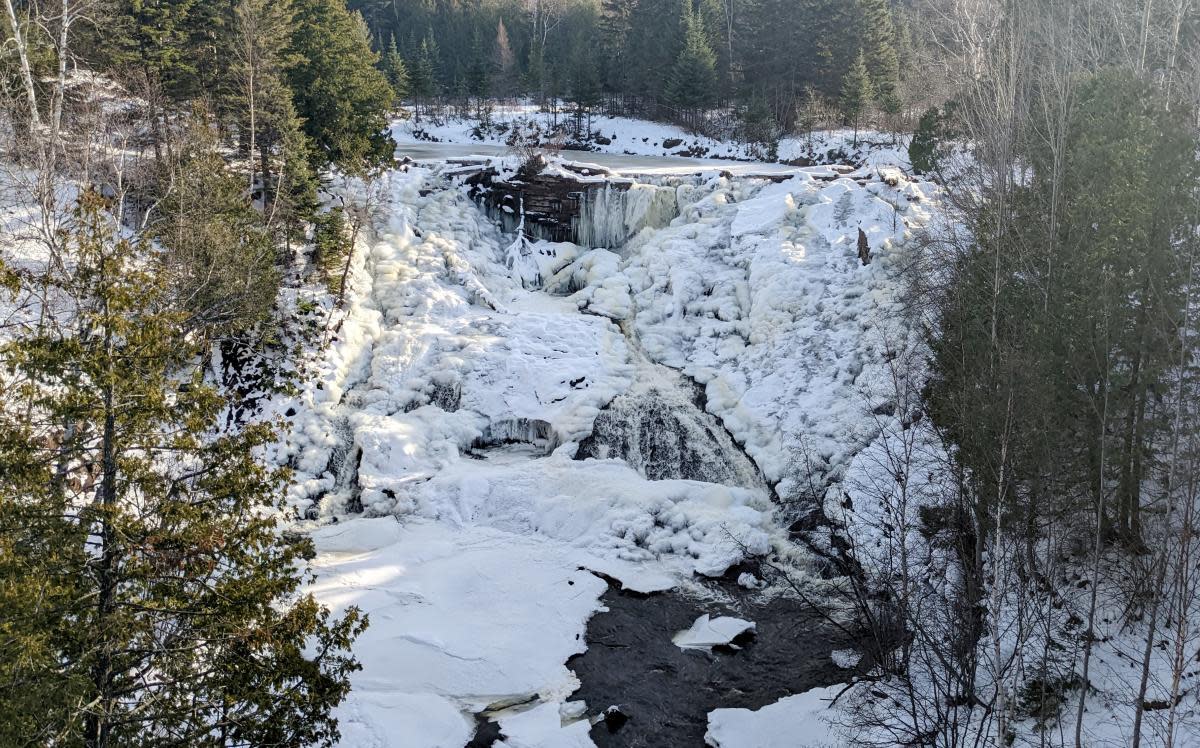
Ice and snow make Lower Eagle River Falls an impressive sight.
The Eagle River Timber Bridge is an impressive wooden arch bridge that was built in 1990 to replace the current pedestrian bridge. The bridge is supported by two adjacent arches that span 74 and 79 feet over the deep gorge. This aesthetically pleasing bridge is one of the most impressive in the Keweenaw and was designed to carry the same traffic loads as our state trunkline concrete and steel bridges.
From the other side of the pedestrian bridge, you will have the most spectacular views of Lower Eagle River Falls. The falls is on the site of the original Lake Superior Safety Fuse Company and remains of the dam still span most of the 60-foot-wide river. This Fuse Company serviced local mining companies during the 1860’s. The dam extends these magnificent falls to a height of well over 60 feet – a beautiful sight when covered in ice and snow.
Eagle Harbor Lighthouse
The red-brick façade of the Eagle Harbor Lighthouse stands out against the snowy white backdrop of winter, forming a truly picturesque scene. While the lighthouse museum is closed during the winter months, visitors are still welcome to explore the lighthouse grounds on foot. This gorgeous lighthouse has served as a vital navigational aid for mariners since its construction in 1851.
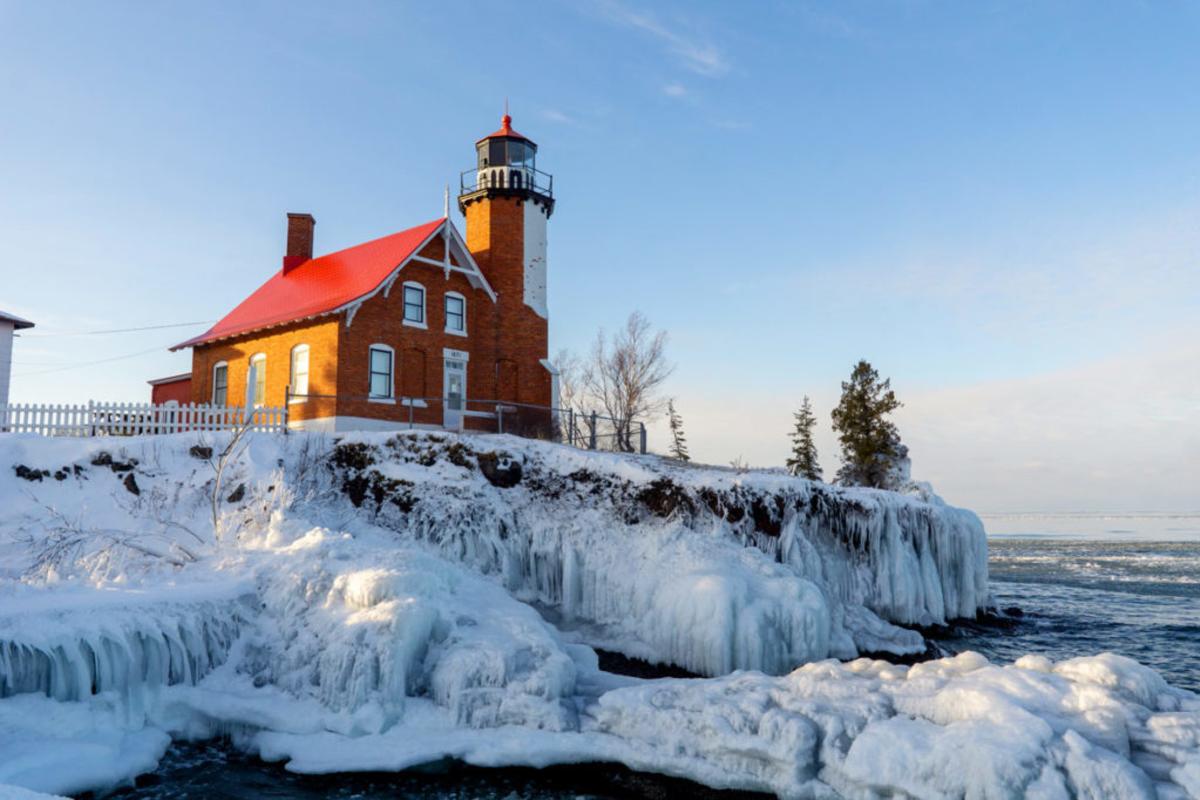
Eagle Harbor Lighthouse looks magnificent atop its ancient frozen basalt base.
The lighthouse was converted to electric in the 1980’s and continues to serve as an important navigational aide today. Bring a pair of snowshoes and take in views of frigid Lake Superior and fascinating ice formations along the ancient volcanic rock and learn about the history of the lighthouse from informational signage on site.
Fort Wilkins Historic State Park
Fort Wilkins was built in 1844 to help keep peace between native people and European immigrant mine workers during the peak of the Keweenaw copper boom. The fort was ultimately deemed unnecessary and only operated for a short period of time. Today, twelve of the original log and frame structures still stand and continue to tell the story of life on the northern frontier during the mid-1800's. During the summer, the park offers a Living History program and provides the visitors with the opportunity to enter various fort buildings, such as old workshops, storehouses, barracks, and more. In the winter, visitors can snowshoe or ski around the park to get a sense of the realities military-men faced during the cold winter months in Copper Harbor.
Fort Wilkins State Park also includes the Copper Harbor Lighthouse. This lighthouse cannot be accessed by car, but it can be seen from the viewing area within the Fort Wilkins Historic State Park. The original light tower was constructed in 1848, and the red-roofed building that you can see today was built in 1866 using stones from the original tower as its foundation. This light was built to help aid vessels navigating Copper Harbor at a time when maritime shipping was essential to the area.
Recreate Responsibly
While you embark on your journey through the rich heritage of the Keweenaw Peninsula, we encourage you to tread lightly and help preserve these historic landmarks for generations to come. Remember that these locations are not just snapshots frozen in time; they are living remnants of the past. Whether you are skiing through Fort Wilkins Historic State Park or marveling at the Eagle Harbor Lighthouse, we ask that you support our efforts to keep the Keweenaw’s history alive by acting as a responsible traveler. Lace up your snowshoes, step into the past, and leave only footprints on this remarkable winter journey through time.
Interested in updates, travel tips and quirky information about the Keweenaw? Just sign up for the Keweenaw Explorer, our monthly e-newsletter. Complete the form…

